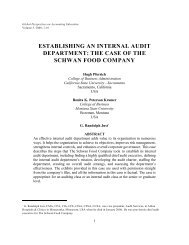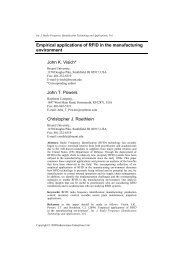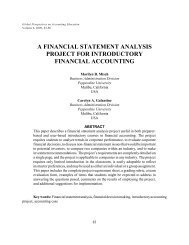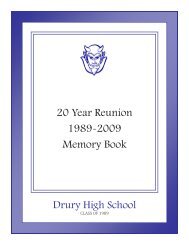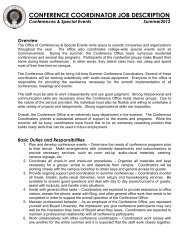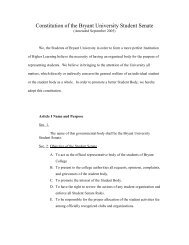Why use multiple-choice questions on accounting - Bryant
Why use multiple-choice questions on accounting - Bryant
Why use multiple-choice questions on accounting - Bryant
Create successful ePaper yourself
Turn your PDF publications into a flip-book with our unique Google optimized e-Paper software.
28 Simkin, Keuchler, Savage, and Stiverrelati<strong>on</strong>ship between performance <strong>on</strong> the MC and CR porti<strong>on</strong>s of the tests.C<strong>on</strong>sequently, the findings from this study suggest that certificati<strong>on</strong> examinati<strong>on</strong>sbased solely <strong>on</strong> MC <str<strong>on</strong>g>questi<strong>on</strong>s</str<strong>on</strong>g> may not be testing applicants at the same level as CRtests might. Gender bias did not appear to be an issue in this study.Key words: Multiple <str<strong>on</strong>g>choice</str<strong>on</strong>g> <str<strong>on</strong>g>questi<strong>on</strong>s</str<strong>on</strong>g>, c<strong>on</strong>structed resp<strong>on</strong>se <str<strong>on</strong>g>questi<strong>on</strong>s</str<strong>on</strong>g>, test formats,certificati<strong>on</strong> examinati<strong>on</strong>s, gender biasData availability: Data are available from the third authorINTRODUCTIONThe <strong>accounting</strong> literature suggests that professi<strong>on</strong>al certificati<strong>on</strong> is important to, and desiredby, employees, employers, and professi<strong>on</strong>al organizati<strong>on</strong>s. Potential pers<strong>on</strong>al benefits toindividuals who earn certificati<strong>on</strong> include (1) pride in accomplishment, (2) officialrecogniti<strong>on</strong> of the recipient’s knowledge, (3) enhanced career advancement opportunities, (4)impetus to improve work and communicati<strong>on</strong> skills, (5) increased job security, (6) ability to qualifyfor work in sensitive governmental or corporate areas, and (7) financial remunerati<strong>on</strong> (Grigsby,2000; Summerfield, 2008).Employers also gain when they encourage their employees and job applicants to obtainprofessi<strong>on</strong>al certificati<strong>on</strong>s. Benefits include (1) an independent metric with which to screen jobapplicants, (2) a knowledgeable work force, (3) assurance of c<strong>on</strong>tinuing educati<strong>on</strong> of employees,(4) greater currency in the field, (5) enhanced employee understanding of matters and c<strong>on</strong>ceptsbey<strong>on</strong>d their immediate job descripti<strong>on</strong>s, (6) availability of objective criteria with which to awardraises and promoti<strong>on</strong>s, and (7) an objective rati<strong>on</strong>ale for dismissing employees who repeatedly failcertificati<strong>on</strong> tests (Christensen, 1998).Finally, benefits often accrue to the professi<strong>on</strong>al organizati<strong>on</strong>s that offer certificati<strong>on</strong>s,including (1) enhanced recogniti<strong>on</strong> and stature of the sancti<strong>on</strong>ing organizati<strong>on</strong>, (2) ability to tailorcertificati<strong>on</strong> tests to specific technical areas, (3) greater understanding of the strengths andweaknesses of test takers, (4) enhanced ability to provide feedback to relevant parties, and (5)revenues from examinati<strong>on</strong> fees (Grigsby, 2000; Summerfield, 2008).Like many other professi<strong>on</strong>s, the field of <strong>accounting</strong> has a wide range of professi<strong>on</strong>alsocieties and c<strong>on</strong>comitant certificati<strong>on</strong>s. Table 1 provides examples, listed alphabetically bycertificati<strong>on</strong> name. One of the oldest and most respected–the certified public accountant (CPA)credential–has such stature that many university <strong>accounting</strong> programs “teach to” this exam and<strong>accounting</strong> programs are sometimes judged <strong>on</strong> the basis of the pass rates of their students <strong>on</strong> it(Jacks<strong>on</strong>, 2006).If certificati<strong>on</strong> examinati<strong>on</strong>s are important, then so are the types of <str<strong>on</strong>g>questi<strong>on</strong>s</str<strong>on</strong>g> <str<strong>on</strong>g>use</str<strong>on</strong>g>d <strong>on</strong> them.Test takers, employers, and the test developers themselves have at least <strong>on</strong>e objective in comm<strong>on</strong>:assurance that the <str<strong>on</strong>g>questi<strong>on</strong>s</str<strong>on</strong>g> <strong>on</strong> these assessments are fair and unbiased, and that the tests themselvesaccurately and equitably measure the applicants’ knowledge in the subject area.In most cases, the <str<strong>on</strong>g>questi<strong>on</strong>s</str<strong>on</strong>g> <strong>on</strong> certificati<strong>on</strong> examinati<strong>on</strong>s can be classified as either: (1)machine-gradable, <str<strong>on</strong>g>multiple</str<strong>on</strong>g>-<str<strong>on</strong>g>choice</str<strong>on</strong>g> (MC) <str<strong>on</strong>g>questi<strong>on</strong>s</str<strong>on</strong>g> that offer several possible alternative answersto each questi<strong>on</strong>, or (2) c<strong>on</strong>structed resp<strong>on</strong>se (CR) <str<strong>on</strong>g>questi<strong>on</strong>s</str<strong>on</strong>g> such as essays, simulati<strong>on</strong>s of real-


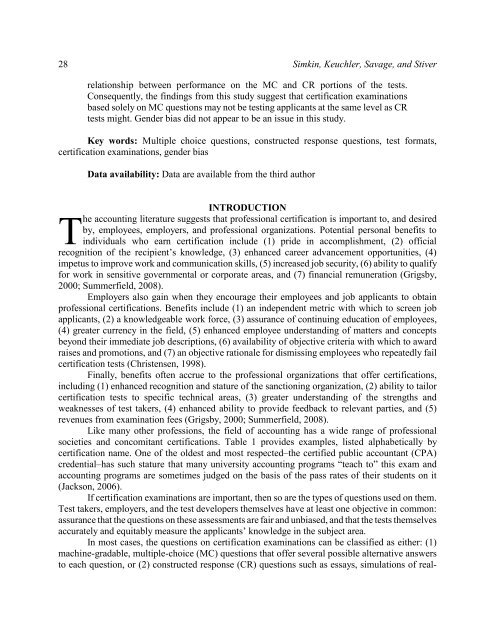
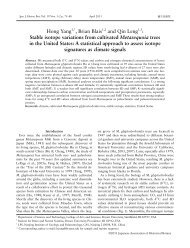
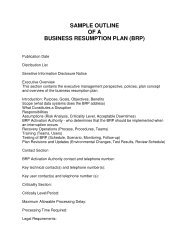
![[1] The Legal Environment of Business (LGLS211) Andrea Boggio ...](https://img.yumpu.com/45269009/1/190x245/1-the-legal-environment-of-business-lgls211-andrea-boggio-.jpg?quality=85)
